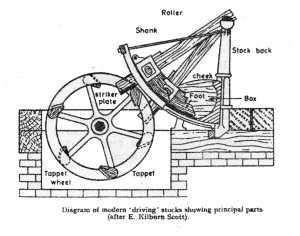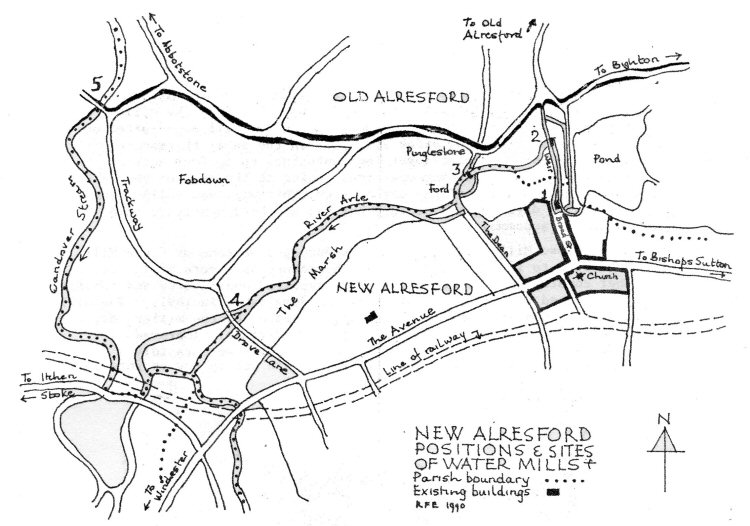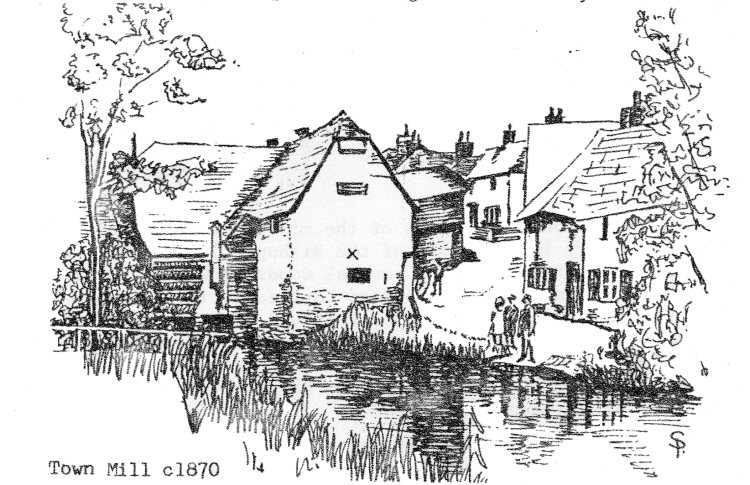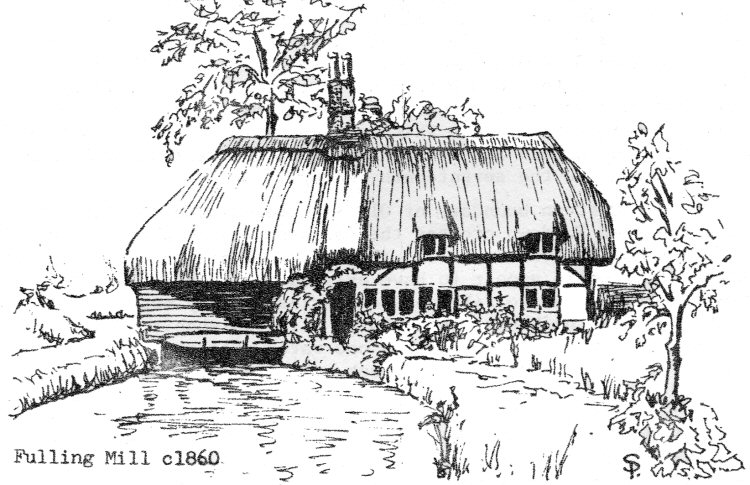N0. 61 - THE WATER MILLS OF ALRESFORD
by Raymond Elliott.
The Domesday Survey records that in 1086 many water mills were established on the waters of the Itchen valley, of which nine stood in the Liberty of Alresford; this suggests that Alresford was a busy centre for corn and cloth, such products then passing easily through the Market Town situated on the south bank of the river. This thriving industrial centre, owned by the Bishop of Winchester, would also have served many surrounding estates and became a source of much trade and wealth.
But the flow and control of the waters of the Itchen were to be dramatically rearranged and improved. In the mid twelfth century Bishop Henry de Blois acquired adjacent Sutton (now Bishop's Button) from his brother King Stephen, and commenced the great project of building a fine new palace therein together with a new fishpond to provide a plentiful supply of food. Completed in the early thirteenth century by his successor, Godfrey de Lucy, together with the additional task of re-building the market town itself, the modern Alresford we know today became established.
The process of grinding the corn is generally well understood, but the fulling of cloth, as a milling process, should perhaps be clarified. After spinning the wool, followed by weaving the cloth, the process of fulling can be defined as closing together of the threads of the woollen fabric by pressing and kneading in a soapy liquid such as fullers earth. The constant kneading or hammering in the fulling stocks tightens the weave, thickens the cloth and reduces the area by shrinking.
 Originally fulling was performed by laying
the woven material in a shallow stream
and treading or 'walking' the cloth ' but
development of water power vastly revolutionized
the process. 'Walking' was a worldwide
manufacturing activity in ancient
times, and such references can be found
in the Bible. It is not clear at what time
the water driven mill wheel was first applied
to grinding corn in this country but by
the time of the Domesday Survey there were
a considerable number of mills recorded.
The application of fulling stocks is however
more certain when, in 1208 London fullers
complained that cloth was being sent out
of the City to be fulled by mills instead
of the old practice of treading with the
feet. And in Old Charters, one of the earliest
is the Pipe Roll of the Bishopric of Winchester
of 1208 which mentions fulling mills at
Alresford, Bishop's Sutton and Bishop's
Waltham.
Originally fulling was performed by laying
the woven material in a shallow stream
and treading or 'walking' the cloth ' but
development of water power vastly revolutionized
the process. 'Walking' was a worldwide
manufacturing activity in ancient
times, and such references can be found
in the Bible. It is not clear at what time
the water driven mill wheel was first applied
to grinding corn in this country but by
the time of the Domesday Survey there were
a considerable number of mills recorded.
The application of fulling stocks is however
more certain when, in 1208 London fullers
complained that cloth was being sent out
of the City to be fulled by mills instead
of the old practice of treading with the
feet. And in Old Charters, one of the earliest
is the Pipe Roll of the Bishopric of Winchester
of 1208 which mentions fulling mills at
Alresford, Bishop's Sutton and Bishop's
Waltham.
In the new and reconstructed market of Alresford Burgus all properties and land were held by copyhold and thus the Bishop's new investment produced a good income; the rents were collected by the Reeve, including profits from the market stalls, and accounted to the Bishop's palace at Winchester.
The construction and repairs of the mills however, including renting, was wholly in the hands of the Bishop. Timber would be selected from one of 'the Lords' several woods in Wessex, fabricated in the work area there and then carted to the particular site and erected. Repairs and reconstruction followed from time to time as necessary. Fulling stocks and machinery timbers for working the mills would also be supplied and fitted; but for grinding corn the new and replacement mill stones were carted from Hampton or other south coast port at the Bishop's expense.

Researches also indicate that when reviewing the life of milling in Alresford - which continued for a period of some seven hundred years the industry continually ebbed and flowed. The mills flourished and declined, tenants passed on after a lifetime of milling, some followed father and son, and so on; there were times of disuse as well as plenty. Over the years buildings and/or machinery required repairs or renewal, or after emptiness and dereliction a new building would become necessary. Also climatic conditions, crop failures and pestilence, even periods of local war and conflicts, had much effect on want or prosperity in the life of rural Hampshire and all these factors left their mark. From this pattern of changing life, especially after destruction or neglect, or the impact of new personalities, the name of each mill was subject to change and change again. The records give a proliferation of names, some of which cannot now be accurately located; some probably existed only during the tenure of one or two successive millers.
A number of fishponds were constructed by the succeeding Bishops of Winchester in medieval times in order to improve the supply of food and income to their several houses in Hampshire and beyond. At Alresford the outlet from the new pond also provided a fine source of power or energy, although today it may be seen only as a gentle stream.
The channel flowing under the bridge at the northern end of "Broad Street, with "the outlet gate or shuttles controlled try the miller provided much power to the mill, wheel. The Town Mill constructed on the site of the existing brick structure in the early thirteenth century was able to drive (over the centuries) up to four sets of grinding mill stones at any one time. Being at the head of the waters and an essential part of the market town, this mill was still in use in the early days of this century but has now been converted into residential accommodation.
1 - The Town Mill, known at times as Borough, Nortons or Upper Mill, is referred to in the early thirteenth century as a corn mill. Of timber construction it would have been repaired and altered and rebuilt, and continued to grind corn until it was demolished in 1891. The mill had been purchased from the Bishop of Winchester by the miller, Mr. William Hall and soon after he decided to modernise. Improved industrial techniques in the late Victorian times were rapidly increasing and the growing and milling of corn was by now an international industry. The Town Mill was therefore replaced by the brick structure we see today, but it now housed roller mills in place of mill stones. Later the milling of corn was succeeded by cattle and poultry foods but this also ceased when the miller retired in 1964. Milling had thus been a continuing activity on this site for over seven hundred years.
3 - The old Fulling Mill nestling today amongst the trees at the eastern end of Pinglestone Road ford is a charming example of a medieval timber and thatched building that has been converted into a modern house. It is perhaps pertinent to pause and study the Edwardian postcard photographs in order to reveal the original appearance of this ancient structure. See the blackened timber boarding under the coarse thatching and the absence of trees, a stark image in place of the glamour and romance of this well known picturesque beauty spot in Alresford today. This mill is probably on the site of the first fulling mill built in Alresford, It is recorded in the early thirteenth century being erected after the upper reaches of the river had become normalized following the construction of Godfrey de Lucy's embankment and pond, In many later title deeds of Alresford these wetlands and river became referred to as 'the Mershe' and today contain watercress beds and trout farms. Early in the thirteenth century the miller's name of Jordan is recorded, later followed by Henry Andrews, which continued for many years. Andrews Mill is constantly associated with 'Dene bridge' and from the records of repairs this would be a timber footbridge that spanned the leet stream (of the mill) where it rejoined the river downstream. Now rebuilt in brickwork this bridge forms part of the access footpath between the fulling mill and its junction with the north end of The Dean roadway today.

Constructed by the Bishop of Winchester, the fulling mill would have required repair to the fulling stocks as well as the structure due to the lift and fall of the hammers, and much noise must have echoed across the valley. With the beginning of the Industrial Revolution throughout the country during the nineteenth century the processing of cloth passed to the northern provinces and with newer mechanical techniques the simple fulling as performed in Alresford declined and ceased. The building survived due to being occupied as a dwelling and during the years the machinery and stocks were removed. John Freemantle was the occupier in 1803 followed by his son Henry in 1834, continuing for many years and even after the last war it was at one time used as headquarters for the local scouts. However, standing empty, derelict and decaying the mill was taken over by Mr. Brian Gush in 1951. Carefully restored, repaired and modernised we all admire the beautiful home we see today together with its handsome lawn and gardens.
4 - There is a record of 'walking' or 'beating' the bounds of New Alresford in the eighteenth century which when crossing modern Drove Lane, from west to east, states "close to Burrow Meadow fence close to Tottons Meadow....near Stoke Hatches leave a small dry island in Old Alresford liberty where formerly was a mill ... " and so on. This would be the site of the New Mill built in the mid fourteenth century known as Jones Mill or Johnnes, Black, Jennings, Willow or Far Mill, constructed on Burrough Mead. It became derelict by the latter part of the sixteenth century and was then rebuilt. It was a fulling mill which had main and leet streams somewhat similar to the surviving mill at the bottom of the Dean. This mill was also described as standing next to Tothorne Mead and it may have been the fulling mill taken down by Henry Perin in the seventeenth century.
5 - On the western boundary of Old Alresford where the trackway to Abbotstone and Fobdown crosses the Candover Stream would be the site of Bubblesham or Fobdown Mill. There are few references available and clear but it would appear to have existed for some two hundred years from the thirteenth to fifteenth centuries. Early notes refer to this mill being 'in the hands of the Lord' (i.e. uninhabited) but by 1361 we find 'Joan wife of John ffykin one water mill at Fobdene'. Later the miller was Thomas Loker who took over from William Gervas in the late fifteenth century, then known as Babblesham Mill on Fobden water. The siting of this mill is a mile and a half distance from Alresford Burgus but it would have been well served by the trackway (now road) from Old and New Alresford to the farm of Fobdown. It is not clear if this mill was a corn or fulling mill, but its distance from the market place would suggest it was used for grinding corn.
Copyright Raymond Elliott July 1989
Sources : Newcomen Society Transactions Volumes VII XII XIV XVIII & XXX
The Manufacture od Woven Goods - Tomlinsori
The Esgair Moel Woollen Mill - Welsh Folk Museum
SPAB Fulling Mills - Dr. Pelham British Water Mills - Leslie Syson
The Fulling Mill. Old Alresford - Isabel Sanderson
Dwellings in Alresford 1-10 - Isabel Sanderson
Early Cloth Fulling and its machinery - E. Kilburn Scott